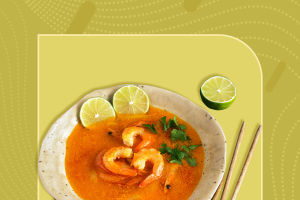When we talk about a type of dish that is eaten in practically every country in the world, the soup certainly deserves to be highlighted. Its origin dates back to the discovery of fire, which brought the possibility of cooking meats and vegetables. In this way, the history of soups is tied with the history of humanity itself, with each region incorporating its flavours and ingredients into this preparation.
Despite the immense variety of recipes around the world, one fact is inherent in all soups: their characteristic of providing comfort and hospitality. If you’re also a fan of this emblematic dish, here are 5 typical soups over the world that you have to try.
1. Gazpacho (Spain)
Spain’s most famous soup comes from its Mediterranean region, Andalusia. It is no wonder that the flavour of this typical Spanish dish is the result of fresh ingredients such as tomatoes, garlic, onions, pepper and olive oil. The name Gazpacho, in Arabic, means wet bread, since this soup is usually eaten cold accompanied with a piece of bread. Nowadays, the gazpacho recipe has several variations, which include the use of almonds, avocado, melon, watermelon, among other ingredients.
2. Laksa (Malaysia and Singapore)
Southeast Asia is known for its dishes with very complex and often contrasting flavours. Asian soups fit perfectly into this food culture, one of the most famous being Laksa, which is especially consumed in Malaysia and Singapore. Although there are several variations in its preparation, Laksa’s recipe is based on a broth made with spicy curry, ginger and coconut milk. To serve, it can be complemented with shrimp, chicken, tofu and traditional oriental noodles. It is believed that the origin of this soup comes from a fusion between Chinese culture and that of the countries of Southeast Asia, as it combines ingredients typical of all these regions. There are theories that suggest that the name of the dish comes from Cantonese meaning “spicy sand”, a reference to the texture and flavour of this typical soup.
3. Yayla çorbası (Turkey)
Yoghurt, one of the most used ingredients in Turkish cuisine, is the basis for the country’s traditional soup, Yayla çorbasi. In this preparation, rice and chickpeas are cooked in a broth flavoured with spices and herbs. Yoghurt is what brings creaminess to the soup, and can be complemented with feta cheese. Yayla çorbasi originated with the Assyrian people, who inhabited the region of Turkey in antiquity. Its name means “soup of the mountains” since it is widely consumed by the peasants of the mountainous regions of the country, due also to its high nutritional content. By the way, the nutritional capacity of this soup makes it one of the most recommended in restoring the health of the sick in Turkey, being a prevalent item on the menus of clinics and hospitals.
4. Soupe à l’Oignon Gratinée (France)
The elegant French cuisine features one of the most refined soups in the world, Soupe à l’Oignon Gratinée. Although onion soups were already consumed by the Greek and Roman civilizations, the first documented recipe for this dish as we know it today was prepared by a Frenchman in the 17th century. Initially consumed by poor peasants, due to the affordable price of onions, the soup gained popularity and is now served in all types of restaurants. The great secret of this preparation is to brown the onions in butter until they are dark. When mixed in a seasoned broth, a slightly creamy and velvety soup is formed. Nowadays, it is served with a slice of bread and a nice layer of gratin cheese on top (sometimes too much!).
5. Goulash (Hungary)
One of the most famous soups in the world is Goulash, of Hungarian origin. Its roots merge with the history of their people, who, faced with the need to leave their homes when shepherding animals, prepared meats to take on trips. During preparation, the meat was cooked in a seasoned broth until it dried. At the time of consumption, the shepherds heated them again with water, forming a hot and nutritious soup. Over the centuries, the Goulash recipe has been improved with the addition of paprika and tomatoes, taking the shape we know today. In some preparations, potatoes and pasta are used to enrich the soup.


